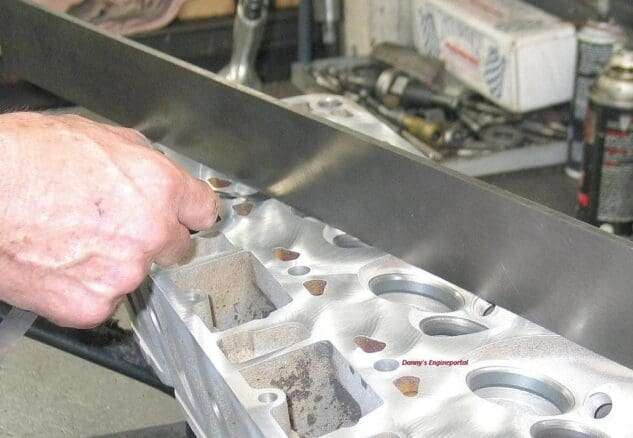
Diagnosing a blown head gasket, just by looking at the symptoms, can be quite misleading.
So, a blown head gasket is NOT a single thing, because it can fail in several different ways.
As a result, many blown head gasket failures are possible, each with different symptoms.
The symptoms that we may notice will depend on how, and where the Blown Head Gasket actually leaks. First, exhaust fumes, immediately destroy inhibitors in the coolant, and set up an acid condition.

This is bad enough, but the coolant will then conduct electricity, and a galvanizing reaction will begin. And, this will eat away at the radiator, and other parts of the system from the inside.
Also, if the coolant should enter the cylinders, the result will be a poorly running engine. Consequently, with less life, and coolant contaminating the engine’s lubricants.
Combustion leaks in the valve area, force coolant away during heavy acceleration, causing excessive heat build up. So, when acceleration stops, the diverted coolant rushes back to that area, resulting in internal engine damage.
Types Of Blown Head Gasket Failures
Adding to the problem of diagnosis, there may be other factors. For example, a warped or cracked cylinder will produce the exact symptom, of a blown head gasket. So, its best to do an external inspection, to determine if the problem is head gasket related.

This may mean a blown gasket, warped or cracked cylinder head. So, removing the head and testing it, is the only way to know the extent of the damage.
Engine Misfire, Caused By A Blown Head Gasket
A head gasket that fails between cylinders, will generally cause a misfire, and perhaps few other common symptoms. With a compression leak between cylinders, compression from one cylinder, leaks into another.

Lowered compression results in a, rough idling engine. Damage of this type may not cause overheating, coolant in the oil or any other outward sign.
Fluid Mixing, Oil In The Coolant And Coolant In The Oil
Head gaskets may also fail between the coolant passages, and the lubrication system. This type failure may show up as oil in the coolant, or coolant in the oil. It is also common to find failures, between an oil passage and the outside. Fluid mixing is not good, and needs to be fixed quickly.

Such damage results in an external oil leak, and possibly no other symptom. It is also possible for multiple failure types to exist in an engine, at the same time.
Cylinder Head Corrosion, Caused By A Blown Head Gasket
Cylinder head surface corrosion is similar to a crack, in the way it affects the gasket. A corroded cylinder head, will not allow the gasket to seal. Such corrosion occurs with improper cooling system service. If the corrosion is severe, you will have to replace the cylinder head. With a less serious case, a cylinder head shop, can restore the surface with machine work.

Warping is another problem, particularly with aluminum cylinder heads. The surface of a cylinder head may warp, and no longer provide a flat surface, to seal the head gasket. After we remove and clean the head we use a straight edge, and feeler blade to check the surface. So, if a problem exists, the feeler blade will pass between the head, and the straight edge.

The specs for an allowable warp, varies from one engine to another. The normal limit is .003 to .004 inches for four cylinder, V6 and V8 engines. With some inline six cylinder engines, the tolerance may be slightly more. Cylinder head shops may straighten, or machine a warped cylinder head to make it usable. They can even sometimes repair, cracked cylinder heads.
Hydrocarbon, Coolant Testing
This works with virtually any liquid cooled internal combustion engine, with a closed cooling system. And, also works on gasoline, diesel, propane, natural gas and other alternative fuels. This is the best way to check for a blown head gasket.

An alternative would be, the old school method as follows:
- Get the engine ready for testing, as if you were going to do a compression test.
- Remove all the spark plugs and the rad cap.
- Screw in an air line fitting into a spark plug hole, and apply full shop air line pressure.
- Turn the engine over by hand or wrench, to make sure all the valves are closed on that cylinder.
- Once pressure has built up on that cylinder, check the rad for air bubbles.
- Do the same to all other cylinders, looking for air bubbles.
If there were no bubbles your OK. If there were, you have confirmed a leak or blown head gasket.
Conclusion
So, prevention is much better than cure, when it comes to head gaskets. Consequently, a replacement head gasket itself is not too expensive, but the repair is very labor intensive.

Above all, head gasket failures are usually the result of an engine overheating. So, the best way to prevent a head gasket leak, is to ensure your cooling system is in good condition.
Above all, ensure the system has no leaks, the radiator is working efficiently. And, the engine coolant is topped up to the correct level. Also, make sure the electric fans are working correctly. And, that the thermostat opens, at the temperature it should. Because, all this can help you avoid a blown head gasket.
BY DANNY BENDER




